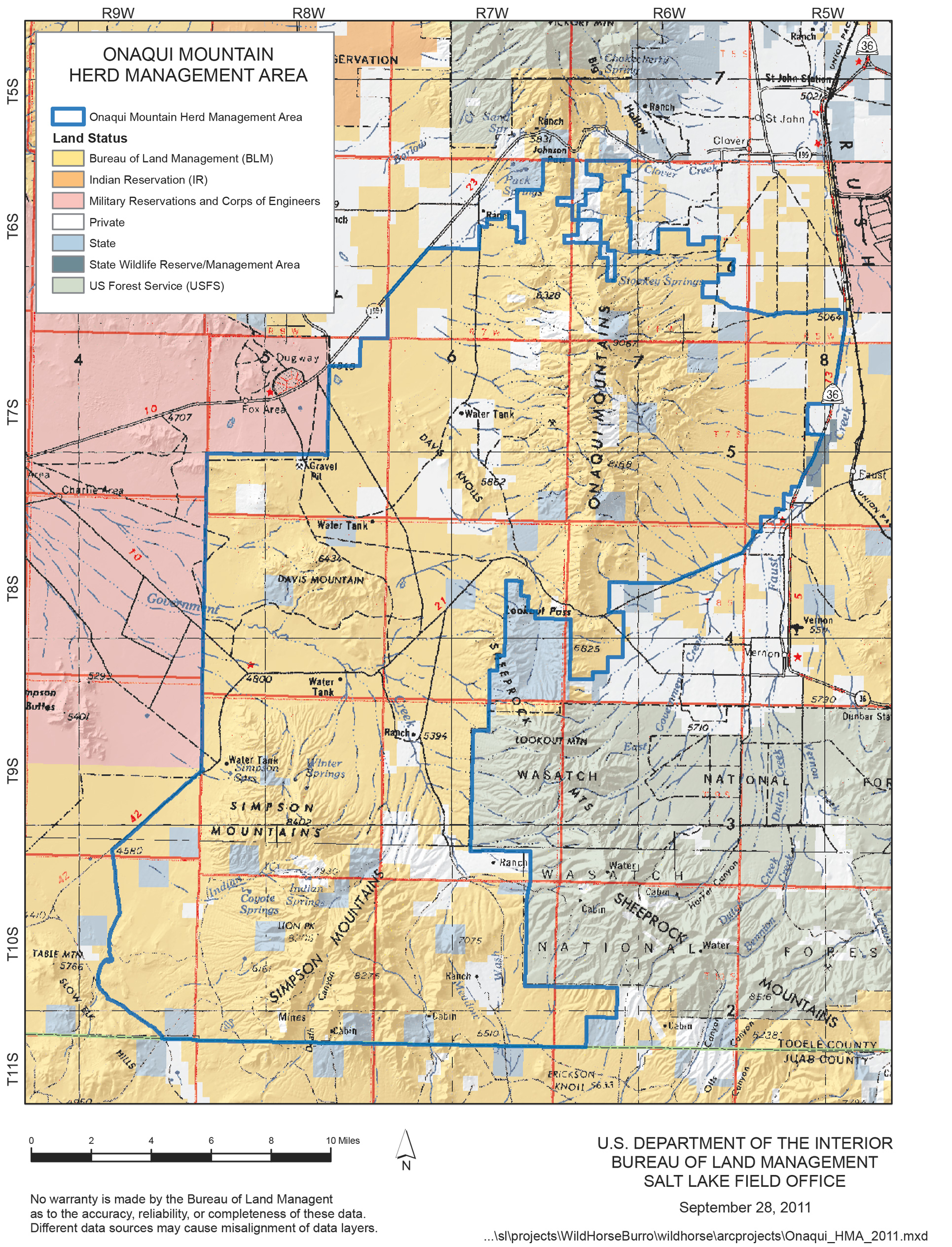Onaqui Herd

Wild Horses of America Foundation has partnered with the Bureau of Land Management (BLM) to administer the contraceptive Porcine Zona Pellucida (PZP) (link to our new PZP page) to select mares of the Onaqui Mountain Herd, which is located in the west desert of Utah. The goal of this project is to control the herd’s reproduction rate in order to minimize (and hopefully eliminate) the use of helicopter gathers that have been used in the past to control herd size.
We feel that PZP is the best tool available right now that can effectively manage herd numbers while best preserving the horses’ natural behavior. Please visit our PZP page to learn more about this important contraceptive.
Our partnership with the BLM is purely as a volunteer to help administer the contraceptive. The BLM is not paying Wild Horses of America Foundation, our employees, or our volunteers for this work, nor is the BLM reimbursing us for any of our expenses (travel, dart rifle, darts, time, etc.). Please consider making a contribution (link to donation page) to help advance this work.

Onaqui Mountain Herd Location Map (Click to enlarge)
LOCATION: The Onaqui Mountain Herd Management Area is located near the Dugway Proving Grounds, and is about 90 miles southwest of downtown Salt Lake City. It takes about 90 minutes to drive there on paved roads.
The two major roads within the herd area are gravel/dirt roads that are suitable for passenger cars when dry. They are usually well maintained, but do take a beating during the winter. There are also some secondary dirt roads that require high clearance and possibly four-wheel drive. (Be advised that all roads in the herd area can become difficult, or impassable, to travel after rain or snow. We know of three vehicles in the past year that have had to be towed out after getting stuck in the mud.)
There are no services (food, gas, etc.) within the herd area. Please be properly prepared if you visit. Depending on your service provider, cell coverage is usually acceptable when you are north and east of Davis Mountain, but is mostly nonexistent northwest, west and south of Davis. There is also no service in the Simpson Springs area, or to the south.
To preserve the forage for the horses and other wildlife PLEASE ONLY DRIVE ON ESTABLISHED ROADS. Not only will your tires damage the range, your tracks may encourage others to follow. The law enforcement ranger for this area will ticket violators.
HERD STATS: The BLM has established an Appropriate Management Level (AML) of 121-210 horses for the Onaqui Herd. Currently, BLM estimates (Spring 2016) that there are about 381 horses in the Herd Management Area. The goal of the contraceptive program is to maintain a herd of approximately 165-175 adult horses.
HERD COUNTS: Wild Horses of America Foundation is very concerned about maintaining the prescribed number of herd members. This is important for genetic viability, long-term herd sustainability, and in proving to the public and other advocacy groups that the contraceptive program is beneficial for the horses.
Periodically, we count all of the horses that we can find in the field. While accurately counting horses in the wild is difficult, especially when done from the ground, we feel that this is important information. Our initial intent was to publish these counts, but some people have expressed concern about this. So, we are going to keep the numbers private for now. Our tallies vary greatly depending on the day. Sometimes we see as few as 10 horses, and once we counted over 170. The average day is usually between 50-130.
We are planning to do an aerial survey in the spring of 2016 since it is very difficult to find some of the groups of horses from the ground.
FOAL WATCH 2016: We’ve had quite the bumper crop of Onaqui foals this year. You can see pictures here. (Please link to our new Photos & Video page) As much as we love seeing babies on the range, our goal is to reduce (not eliminate) the birthrate as the PZP program becomes more effective.
HISTORY: The BLM has used helicopter gathers to reduce the size of the herd in the past. During the 2005, 2009 and 2012 gathers some of the gathered mares were treated with PZP-22 (link to PZP page) (a PZP variant that was designed to provide a time-release aspect that was intended to counter contraception for about 2 years) and released. Currently, there are about 50 mares in the herd who have been previously treated with PZP. You can identify them by the following brands:
• All treated mares were given the BLM alpha angle neck freeze brand (please add hyperlink: http://www.blm.gov/wo/st/en/prog/wild_horse_and_burro/What_We_Do/wild_horse_and_burro0/freezemarks.html)
• “BH” hip brand: Mare was treated in 2005
• “1” next to the neck brand and no hip brand: Treated in 2009
• “BZ” or “BH” hip brand and “3” neck brand: Treated in 2012
• “BZ hip brand and “1” and “3” neck brand: Treated in 2009 and 2012
• “BH hip brand and “1” and “3” neck brand: Treated all three years (5 horses fall into this category)
The brands are unsightly on a wild animal, and we are now tracking treated mares using pictures and physical descriptions.
Contrary to the claims of some animal advocates that PZP “permanently sterilizes” mares, quite a few of these “PZP mares” produced foals this year, and in previous years. (In fairness to the alarmists, individual mares may react differently to being treated with PZP, and there are some who may become permanently sterile. However, this is a rare exception as the vast majority return to regular fertility after the PZP regimen is suspended or stopped.)
Here is a picture of a “PZP mare” and her young foal. (There are more pictures of PZP foals on our PZP page.)
The young filly in the picture was born to the branded mare in November 2015. Her older brother (far left) was born in Fall of 2014. The mare was recently (March 2016) treated with PZP, but given her schedule we suspect she may already be pregnant.
MANAGEMENT PLAN: We suggest you read the following BLM documents pertaining to the fertility control plan for the Onaqui herd as there is a lot of good information in them:
Environmental Assessment (please link to doc I sent to you)
Decision Record (please link to doc I sent to you)
The primary goal is to reduce the reproductive rate of the herd so that helicopter gathers are not used to control herd size. Selected mares who are at least 18 months of age will be treated until they are 5 years old. Then, treatment will be suspended until each the mare has produced a foal who has survived for at least one year.
The mares are being treated with ZonaStat-H which is an emulsion of PZP and an adjuvant. The Science and Conservation Center (link: http://www.sccpzp.org/) in Billings, Montana manufactures it at a cost of about $26 per dose. The BLM will be paying for the ZonaStat-H, but Wild Horses of America has offered to cover the cost if needed.
Each mare requires a primer and a booster for the PZP to reach peak performance. The mares who the BLM caught and released (branded mares) only require the booster. We gave primers to 12 horses (1 of which is now deceased) in the fall of 2015, and plan to do a few more this year.
If a mare has been treated previously (i.e. the branded mares who were caught, treated and released) then only an annual booster is required.
We plan to treat a total of about 40 horses in the Spring of 2016.
Each dose will be delivered remotely, by dart gun/tube, and does not require that the mare be rounded-up and/or held captive.
The PZP emulsion is loaded into a rifle dart that is manufactured by Pneu-Dart. The dart is delivered by use of a CO2 powered gun. When the dart hits the horse a firing pin within the dart ignites a small charge that pushes a plunger to inject the PZP into the horse and ejects the dart onto the ground.
The darts we use are manufactured by Pneu-Dart: http://www.pneudart.com
Here is a picture of the darts we use:
(Note: These darts are loaded with a practice emulsion that looks different than a real PZP emulsion.) The guns we use are made by Dan Inject: http://daninjectdartguns.com. Here are pictures of the guns that we use to deliver the darts:
Our president, Jim Schnepel, took the PZP training course from The Science and Conservation Center in October 2014 and will be the person initially darting the horses from our organization. Here is a copy of the Certificate of Training.
We are looking for more certified darters and encourage you to take the course. Or, if you are certified, please get in touch with us. (Link to our contact page.)
Please reach out to us if you have questions or concerns about this contraceptive program. Please consider making a donation to help support our efforts.





